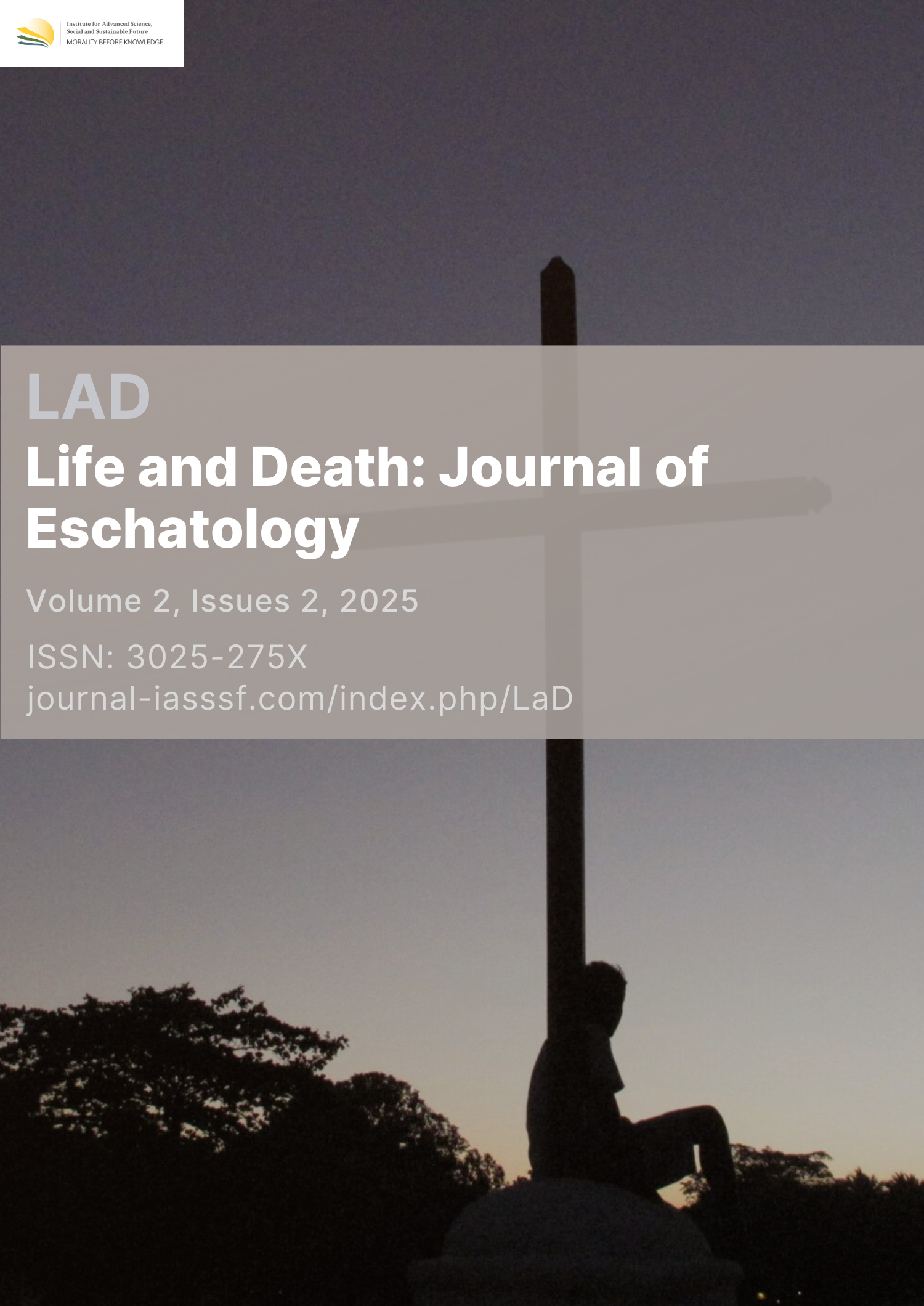The role of rhythm in religious rituals: Supporting the spirituality of Hindu-Buddhist communities in the context of eschatology
DOI:
https://doi.org/10.61511/lad.v2i2.2025.1615Keywords:
music in hinduism, music and rituals, vedic civilizatioAbstract
Background: Music played an important role in the development of Hindu-Buddhist civilization in Indonesia, especially in spiritual life and religious rituals. Methods: This article explores how rhythm and melody became essential elements in the religious and cultural practices of the people during that time. Findings: Music not only served as entertainment, but also as a medium of connection between humans and the supernatural, creating harmony between the mortal and divine worlds. In the Hindu-Buddhist era, music was often used in religious rituals, such as temple worship ceremonies and offerings to the gods. Traditional instruments such as gamelan and gender were believed to have sacred powers that could purify the atmosphere and improve concentration in meditation. Through music, values of spirituality, harmony and devotion are embodied, reflecting the cosmic concept in Hindu-Buddhist teachings of balance between the macrocosm and microcosm. The article also discusses historical and archaeological evidence that shows the involvement of music in religious rituals, such as the reliefs in Borobudur and Prambanan Temples that depict musical instruments and religious processions. The art of music at that time not only showed a high level of aesthetics, but also became a symbol of community identity and togetherness. Conclusion: This paper discusses in depth the role of music as one of the supports of spiritual life that has helped shape the foundation of Indonesian culture and tradition to this day. Novelty/Originaloty of this article: This study uniquely highlights the sacred role of music in Hindu-Buddhist religious rituals in Indonesia, emphasizing its function as a bridge between the mortal and divine realms, which has been rarely explored in previous research.
References
Becker, H. (1993). The sociology of music in the 21st century. University Press.
Becker, J. (1993). Gamelan stories: Tantrism, Islam, and aesthetics in Central Java. Arizona State University Program for Southeast Asian Studies.
Bhatnagar, K. (2022). Description of various Ragas in Vedas and their scientific impact on human emotions. Multidisciplinary Journal. https://doi.org/10.57067/gdvc7x73
Creswell, J. W. (2014). Research design: Qualitative, quantitative, and mixed methods approaches (4th ed.). SAGE Publications.
Desai, S. N. (1970). Rāmāyaṇa—An instrument of historical contact and cultural transmission between India and Asia. The Journal of Asian Studies, 30(1), 5–20. https://doi.org/10.2307/2051026
Deussen, P. (1997). The philosophy of the Upanishads (6th ed.). Cosimo, Inc.
Eliade, M. (1969). The sacred and the profane: The nature of religion. Harcourt Brace Jovanovich.
Geertz, C. (1973). The interpretation of cultures: Selected essays. Basic Books.
Gopinathan, A., & Tan, L. (2023). Om: Singing Vedic philosophy for music education. Philosophy of Music Education Review, 31(1), 4–24. https://doi.org/10.2979/pme.2023.a885189
Heimarck, B. R. (2021). Musical ritual and ritual music: Music as a spiritual tool and religious ritual accompaniment. Muzikološki Zbornik, 58(1), 43–59. https://doi.org/10.4312/mz.58.1.43-59
Iyengar, R. N. (2018). Concept of Śruti, Svara and Rāga of classical music in Sanskrit texts. Indian Journal of History of Science, 53(2), 131–147. https://doi.org/10.16943/ijhs/2018/v53i2/49422
Krom, N. J. (1923). Hindoe-Javaansche geschiedenis. Koninklijk Bataviaasch Genootschap van Kunsten en Wetenschappen.
Kunst, J. (1949). Music in Indonesia: Its history and development. Uitgeverij L.J. Veen.
Larson, G. J. (2001). Classical India: A history of Indian literature, religion, and philosophy. Columbia University Press.
Majumdar, R. C. (2004). The archaeology of early Indonesia. Oxford University Press.
Mancapara, I. G. P. (2022). Filsafat musik dan posisinya dalam Hinduisme. Sanjiwani: Jurnal Filsafat, 13(1). https://doi.org/10.25078/sanjiwani.v13i1.1008
Marsono, & Rahayu, N. W. S. . (2023). Movement of Hindu Religious Education in The Era of The Kingdom of Majapahit. Dharmakirti : International Journal of Religion, Mind and Science, 1(1). https://doi.org/10.61511/ijroms.v1i1.2023.266
Miksic, J. N. (2016). Early history of Southeast Asia: Maritime trade and societal development, 1000 BCE to 500 CE. University of Hawai'i Press.
Miles, M. B., Huberman, A. M., & Saldaña, J. (2014). Qualitative data analysis: A methods sourcebook (3rd ed.). SAGE Publications.
Mishra, S. K. (2024). Harmonies of antiquity: Exploring the Vedic symphony of music and dance: A historical perspective. ShodhKosh: Journal of Visual and Performing Arts, 5(1), 964–968. https://doi.org/10.29121/shodhkosh.v5.i1.2024.2805
Nafde, T. (2021). Relevance of music in Vedic traditions and contemporary context. International Journal for Research in Applied Science & Engineering Technology, 9(6), 4954. https://doi.org/10.22214/ijraset.2021.36036
Padam, A., Sharma, N., Sastri, O. S. K. S., Mahajan, S., Sharma, R., & Sharma, D. (2017). Effect of listening to Vedic chants and Indian classical instrumental music on patients undergoing upper gastrointestinal endoscopy: A randomized control trial. Indian Journal of Psychiatry, 59(2), 214–218. https://doi.org/10.4103/psychiatry.IndianJPsychiatry_314_16
Poerbatjaraka. (1957). Naskah-naskah Jawa Kuno. Penerbit Balai Pustaka.
Pokharel, R. (2021). Developing trends of music in the Vedic and mythological eras. Sirjanā: A Journal on Arts and Art Education, 7, 61–65. https://doi.org/10.3126/sirjana.v7i1.39352
Possehl, G. L. (2002). The Indus civilization: A contemporary perspective. Oxford & IBH Publishing.
Soekmono, R. (1973). Pengantar sejarah kebudayaan Indonesia. Kanisius.
Stutterheim, W. F. (1936). Studies in Indonesian archaeology. Martinus Nijhoff.
Sumarsam. (1995). Gamelan: Cultural interaction and musical development in Central Java. University of Chicago Press.
Surpi, N. K. (2023, April). Ramayana: A drop of amrita in Nusantara (Hermeneutic study of text and context of Hikayat Sri Rama). In ICOHIS: International Conference on Hindu Studies (pp. 403–418). http://conference.uhnsugriwa.ac.id/index.php/icohis/article/view/31/61
Surpi, N. K., Wika, I. M., & Widyastuti, N. P. (2024). Teologi Parabrahman: Candi Prambanan pusat ibadah Hindu dunia & episentrum spiritualitas. PT. Dharma Pustaka Utama.
Tenzer, M. (2006). Balinese gamelan music. Periplus Editions.
Wika, I. M., Dewi, N. L. P. Y., & Pratiwi, N. W. M. (2023). Veda as a source of Dharma teaching for character development in globalization. Dharmakirti: International Journal of Religion, Mind and Science, 1(1). https://doi.org/10.61511/ijroms.v1i1.2023.267
Downloads
Published
How to Cite
Issue
Section
Citation Check
License
Copyright (c) 2025 Jyothi Devi Krishnanandayani, Eshita Chakraborty

This work is licensed under a Creative Commons Attribution 4.0 International License.















